Tuesday, 27 September, Kalocsa, Hungary (and puszta with horsemen)
Written 17 November 2022
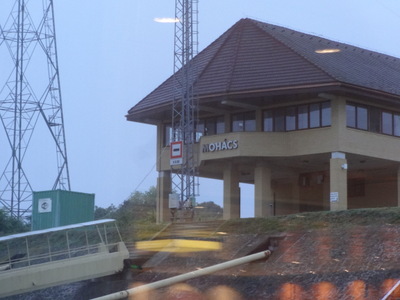 At 5 am, the ship docked in Mohács, our first stop in Hungary (and, I'm told, the site of one of the most important battles against the Ottomans), to clear customs into the European Union. Up to this point, we had left our passports in the hands of the Viking staff, who kept them in a safe and got them out at each national border to check us into the new country without any effort or participation on our part—very convenient. At this point, though, where we officially entered the EU, the Hungarian authorities wanted to do a "face check," laying eyes on each passenger and checking what they saw against the corresponding passport. We were therefore told the night before to go about our business in the morning but to expect further instructions over the PA system.
At 5 am, the ship docked in Mohács, our first stop in Hungary (and, I'm told, the site of one of the most important battles against the Ottomans), to clear customs into the European Union. Up to this point, we had left our passports in the hands of the Viking staff, who kept them in a safe and got them out at each national border to check us into the new country without any effort or participation on our part—very convenient. At this point, though, where we officially entered the EU, the Hungarian authorities wanted to do a "face check," laying eyes on each passenger and checking what they saw against the corresponding passport. We were therefore told the night before to go about our business in the morning but to expect further instructions over the PA system.
When I got up (somewhat later) and looked out the window, I saw only solid white fog. But on the bow cam, I could see fine—maybe we were just moored u[ against a white wall? But no, within a few minutes, the fog outside my window cleared, revealing the Mohács customs building, showed at the left.
Fortunately, although the local officials came aboard bright and early, they did not expect us passengers to present ourselves at 5 am. Shortly after breakfast, the announcement came that passengers in cabins 100 through 125 (that was us; sorry, as an editor, I really should write "those were we") should present themselves in the lounge. The Viking folks had all the passports, each bearing a big white sticker with the corresponding cabin number on it, lined up in plastic tubs. As each of us presented ourselves and announced our cabin numbers, a Viking employee would pull out the relevant passport and hand it to the Hungarian customs guys, who would study the face before them, compare it to the passport photo, nod that we could move on, and hand the passport back to a different Viking employee, who would stow it in the "done and dusted" bin.
It wasn't all that early, really, but I'm told some passengers did appear, bleary-eyed, in their bathrobes.
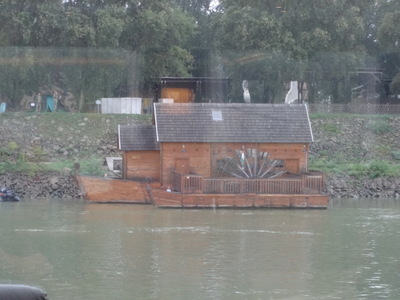
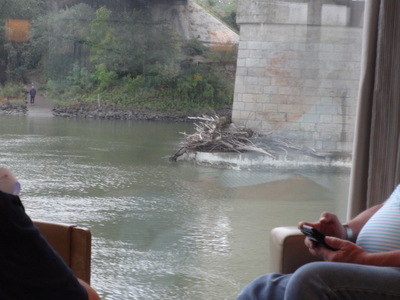 Once all the faces had been checked—our group was first, having the lowest cabin numbers on the ship—we cast off again and sailed on toward our first real stop in Hungary, Kalocsa.
Once all the faces had been checked—our group was first, having the lowest cabin numbers on the ship—we cast off again and sailed on toward our first real stop in Hungary, Kalocsa.
Near Mohács, I spotted this handsome little wooden boat, moored on the opposite bank. Its wheel was not moving, and I couldn't tell whether it was a real, mobile boat powered by a paddle wheel or a stationary mill powered by an undershot water wheel.
Passing under a bridge, I got this shot of debris piled against one of the abutments, testimony to the power of the river when the water is higher. Big rounded flat chunks of something white kept floating by, headed downstream with the current—maybe styrofoam, maybe soapsuds.

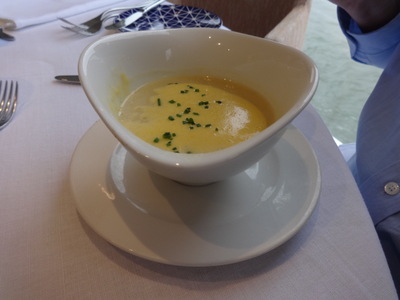 I started lunch with two of the little appetizer salads—another vegetable assortment in mayo (this one flavored with dill) and a cold corn with herbs and bacon. For the first course I chose "corn chowder" with whiskey sabayon. My experience with Viking "chowders" reveals that they have no idea a what chowder is. I asked the waiter, who assured me it had no potatoes in it, so I wasn't suprised to get a sort of corn bisque rather than anything resembling a chowder. Good, though.
I started lunch with two of the little appetizer salads—another vegetable assortment in mayo (this one flavored with dill) and a cold corn with herbs and bacon. For the first course I chose "corn chowder" with whiskey sabayon. My experience with Viking "chowders" reveals that they have no idea a what chowder is. I asked the waiter, who assured me it had no potatoes in it, so I wasn't suprised to get a sort of corn bisque rather than anything resembling a chowder. Good, though.
My main course was pasta carbonara. Again, good, but again, not enough sauce.
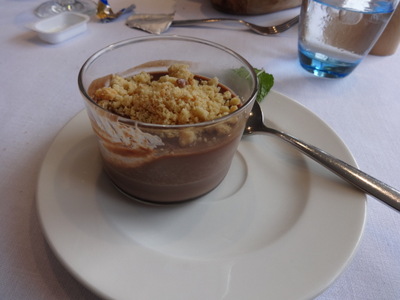
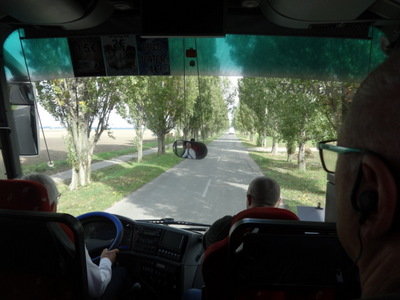 For dessert, we both had the Nutella panna cotta, but a surprising number of diners chose the banana split, which was fairly authentic—a split whole banana with vanilla, chocolate, and strawberry ice cream, topped with a couple of sauces. No whipped cream or cherry, though.
For dessert, we both had the Nutella panna cotta, but a surprising number of diners chose the banana split, which was fairly authentic—a split whole banana with vanilla, chocolate, and strawberry ice cream, topped with a couple of sauces. No whipped cream or cherry, though.
By the time we finished lunch, the ship had arrived and docked at Kalocsa, so we boarded the buses for our excursion to see the town and the "Puszta," the local terrain, usually translated "prairie." As before we drove to town from the dock along a new, arrow-straight road lined with youngish sycamores (Platanus sp.; we call 'em sycamores, Europeans call 'em plane trees).
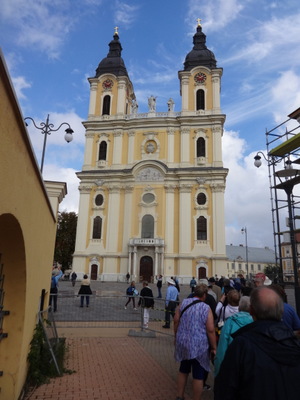
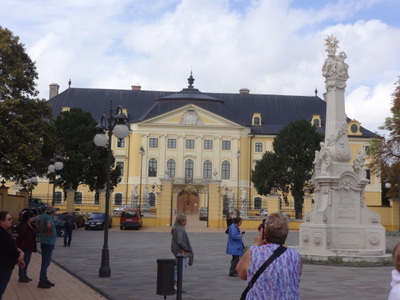 Our guide told us his "proper Hungarian name" is Jerge (though I'm not sure how he spells that), but for today, we would be George.
Our guide told us his "proper Hungarian name" is Jerge (though I'm not sure how he spells that), but for today, we would be George.
Although Kalocsa is a small town (16–17 thousand), it is the seat of one of the archbishops of Hungary (I think there are four) and has a very large cathedral (shown here at the left). George assured us that Budapest is the only big town in Hungary; all the rest are small; people tend to live in small towns.
The first official Hungarian king introduced Roman Catholicism to the area and founded Klocsa, so this is presumably the oldest archbishopric in the country.
From the spot where I photographed the cathedral, if you walk forward about half a block (into the large square in front of it), then turn to the left, you see the Archibishop's Palace, which is shown here in the right-hand photo. In the right foreground of that shot is a large and handsome plague column. The original was "trinity column" was erected in 1786 (the plague was in the 1700's), but it's since been reconstructed with a copy.
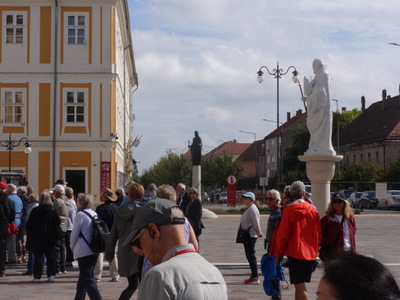
 Looking to the right instead, you see these two statues. The white one is the first archbishop. The darker-colored one, farther away, is Saint Stephen, who was, in fact, that first king of Hungary, the one who founded the town! He was crowned on either 25 December 1000 or 1 January 1001 (opinions differ), and reigned until his death in 1038 (Catholicism and Orthodoxy didn't split until 1054).
Looking to the right instead, you see these two statues. The white one is the first archbishop. The darker-colored one, farther away, is Saint Stephen, who was, in fact, that first king of Hungary, the one who founded the town! He was crowned on either 25 December 1000 or 1 January 1001 (opinions differ), and reigned until his death in 1038 (Catholicism and Orthodoxy didn't split until 1054).
Off in a different direction is a Jesuit church, marked by the tall slender steeple shown here at the right.
The cathedral (Cathedral of the Assumption) and the palace are the oldest building in the town, built in late Italian baroque style in the mid 1700's. The Ottomans demolished everything that was here before, which is why the oldest buildings are so young. This is the 4th church built on the site. The palace Was recently closed for 8 or 9 years for reconstruction but is now open again. The 91st archbishop and a couple of retired priests live there, in the left wing.
The right wing is the archbishop's library, again dating from the 1700's. A fine old and rare book collection was the personal collection of one of the abishops, but he left it to the archbishopric, and they continued collecting. It's now about 160,000 volumes. The oldest is from 1040. It includes
64 handmade, hand illustrated codexes and 500 incunabulae. They even have Martin Luther's bible, the only bible in the world with Luther's handwritten notes.
One room of the library is open to the public. It contains 16,000 books on oak shelves in baroque style, and they are all bound to match. An Austrian book binder lived in the palace for 10 years to rebind them all. The Luther bible is usually there, but it's currently under renovation, so it isn't right now.
Half the books are in Hungarian, Latin, and German; the other half in 85 languages. The have an Eskimo bible and books from Egypt, Mesopotamia, China, and other Asian nations. It's mostly religious books, but also medicine, law, documents from around the world, as well as Mercator maps from the 1600s. The catalog is on line. If you search on Kalocza episcopal library, you can find the website in English; many of the books are digitized and on line in full text.
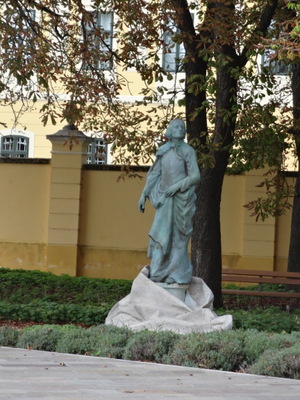
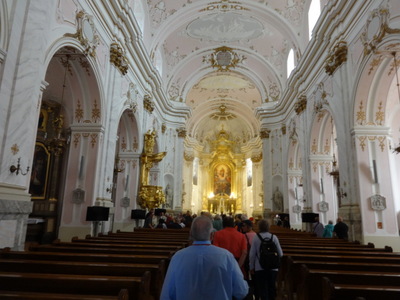 Finally, before we went inside, George pointed out this more-or-less life-size statue of Franz Liszt, with facing the cathedral. Liszt was the best friend of one of the archibishops and stayed as a house guest in the palace six documented times. He played the organ we were about to hear, not for services but for concerts. His piano is in the ceremonial hall in middle of the archbishop's palace.
Finally, before we went inside, George pointed out this more-or-less life-size statue of Franz Liszt, with facing the cathedral. Liszt was the best friend of one of the archibishops and stayed as a house guest in the palace six documented times. He played the organ we were about to hear, not for services but for concerts. His piano is in the ceremonial hall in middle of the archbishop's palace.
Behind the trees beyond Liszt, the teaching school Sisters of Notre Dame have another church, and the building right behind him is a Roman Catholic school.
Here, at the right, is the view that greeted us as we entered the cathedral, looking down the nave toward the altar. The gilded wooden pulpit on the left-hand side is from 1752 and features carvings of the four evangelists.
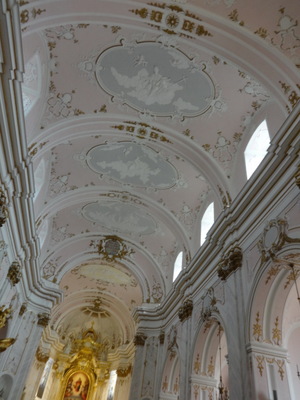
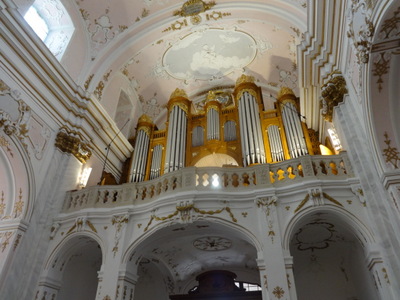 At the left here is a view of the ceiling, looking like it's made of Wedgewood china.
At the left here is a view of the ceiling, looking like it's made of Wedgewood china.
At the right is the organ. It was built by Angster between 1876 and 1877. It has 4668 pipes, 64 variations and 1 pedal. The Angster company still exists, in Pécs. They don't make new organs any more, but they repair their old ones.
The organist who played for us is a priest attached to the Roman catholic archbishopric. My notes on the program are sketchy, but he played, among other things, a Bach c-major prelude, a largo from something, a Pachelbel c-minor toccata, the 6th Charpentier rondo, and the Battle Hymn of the Republic. As we left the square afterward, on our way back to the bus, he waved to us from the balcony on the front of the church.
Next we were off to visit a horse farm on the Hungarian prairie, the puszta, where we would get to watch an exhibition of Hungarian horsemanship!
Things George told us on the bus:
- Hungarian is written in the Roman alphabet, but a version that has 44 letters!
- The population of Hungary is about 10 million, that of Budapest about 2 million.
- The storks will come back in March.
- During the Hungarian uprising of 1956 (against the Soviets, I think), Hungarian Cardinal Mindszenty sought asylum the U.S. embassy and lived there for 15 years.
- We're on the Great Hungarian plane, east of the Danube. I think he said it takes up 1/3 of Hungary.
- The small region here around this town is mud or swamp; the Danube flooded regularly until the river became regulated.
- Nicholas Sarkozy's name comes from the name of this region.
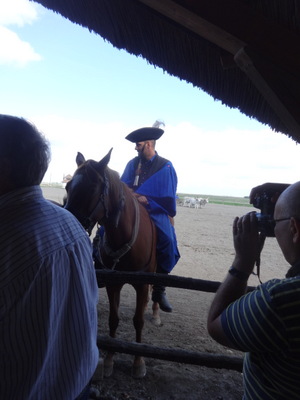
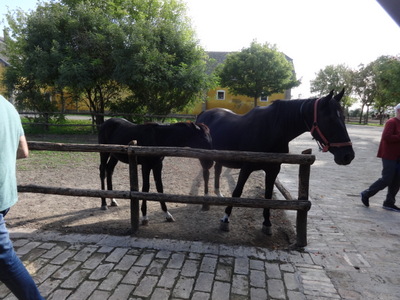 We were met at the turn to the horse farm by a rider dressed like this in a long blue cape and feathered hat and wielding a long cattle whip. Under the cape he wore a blue shirt and trousers with flared sleeves and legs, and over that a black vest. Hungarian riders like this, called "csikos," are shepherds. They were the horse trainers and therefore high in the hierarchy of shepherds.
We were met at the turn to the horse farm by a rider dressed like this in a long blue cape and feathered hat and wielding a long cattle whip. Under the cape he wore a blue shirt and trousers with flared sleeves and legs, and over that a black vest. Hungarian riders like this, called "csikos," are shepherds. They were the horse trainers and therefore high in the hierarchy of shepherds.
The rider who met us led us up the drive to a courtyard where the bus could park. We got to just look around for a few minutes before it was time for the show to start.
This mare and her foal were station conveniently. Their task for the day was to be fed. Nearby was a table heaped with carrots, 1 euro each. The foal didn't seem much interested (could he still have been nursing at that size?), but the mare was happy to stand there and munch as many carrots as our group was willing to buy and hold out to her.
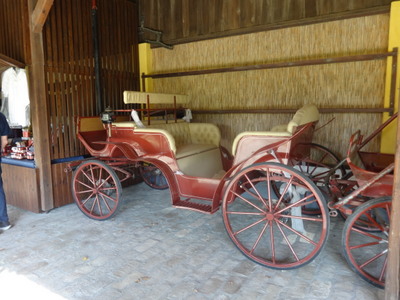
 Several carriages were displayed in an open-sided shed. I thought this one was the handsomest.
Several carriages were displayed in an open-sided shed. I thought this one was the handsomest.
Eventually, we made our way around the building to a set of covered bleachers facing a large fenced enclosure. As we made our way to our seats, we passed this table, where we were offered a snack of sliced country bread spread with lard and sprinkled with paprika. I've always found lard pretty tasteless, but I've always wondered whether that's just because I'd only had overly refined American supermarket lard. I'd hoped this would have more flavor, but it contributed mostly texture; the flavor came from the bread and the sweet paprika.
With the snack we were offered red, white, and rosé wine; strawberry and raspberry juices; and sparkling water. After the show, they brought out the Hungarian brandy. I thought the fruit juices were great.
Written 21 November 2022
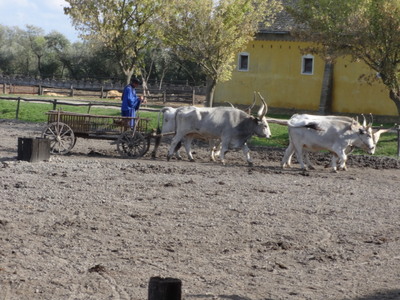
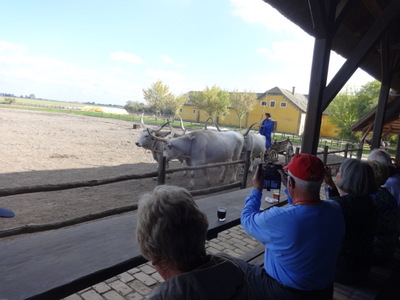 The show started out slow, with these Hungarian Grey cattle. This breed was near extinction in the 20th century, when only about 100 remained. Now, thanks to farms like this one that breed them, they've been pulled back from the brink.
The show started out slow, with these Hungarian Grey cattle. This breed was near extinction in the 20th century, when only about 100 remained. Now, thanks to farms like this one that breed them, they've been pulled back from the brink.
The breed arrived in Hungary maybe as early as the 800's, maybe as late as the 1200's. They live outdoors all year, down to -30C, and eat grass, even under the snow. They are very healthy and are resistant to all known diseases, including mad cow. Their beef is considered to be of high quality.
This team circled the arena a couple of times a walking pace pulling what the narrator called a carriage but which I would definitely characterize as a cart. Their horns were tipped with small shiny balls, which I imagine cut the changes of damage even if all they do is toss their heads.
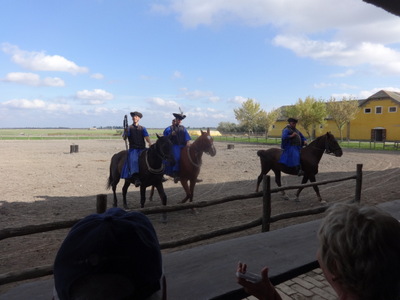
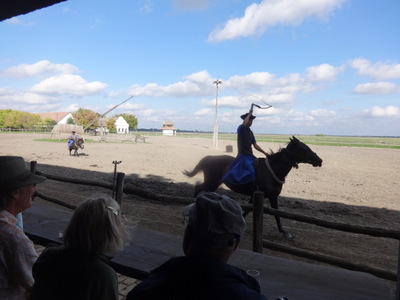 Next, galloping toward us from far away across the arena, came four horsemen with their whips coiled over their shoulders, accompanied by a portly Sancho Panza type on a galloping donkey. The guide told us that the senior rider was the stablemaster and that Sancho was the head trainer.
Next, galloping toward us from far away across the arena, came four horsemen with their whips coiled over their shoulders, accompanied by a portly Sancho Panza type on a galloping donkey. The guide told us that the senior rider was the stablemaster and that Sancho was the head trainer.
They tore around the arena a couple of times, demonstrating their mounts' maneuverability and putting on a display of synchronized whip-cracking.

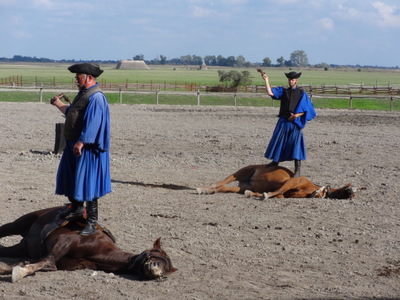 Then came a demonstration of how well trained the horses are. Each one (donkey included) was made to kneel, then lie down, all with the rider still aboard. Each rider laid his saddle aside so that the horse could lie on its side, head on the ground, and legs extended. The riders then sat on the horses, reclined on them, stood on them, then stepped down and made the horses sit like dogs (apparently it's really hard to make a horse do that, and some of the horses were more reluctant than others).
Then came a demonstration of how well trained the horses are. Each one (donkey included) was made to kneel, then lie down, all with the rider still aboard. Each rider laid his saddle aside so that the horse could lie on its side, head on the ground, and legs extended. The riders then sat on the horses, reclined on them, stood on them, then stepped down and made the horses sit like dogs (apparently it's really hard to make a horse do that, and some of the horses were more reluctant than others).
Then the saddles were replaced, and the riders bestrode the horses and made them stand up again. It was only at this point that I realized that, although they used saddles, with stirrups, they used no girths—the saddles were not strapped to the horses, just laid across their backs.
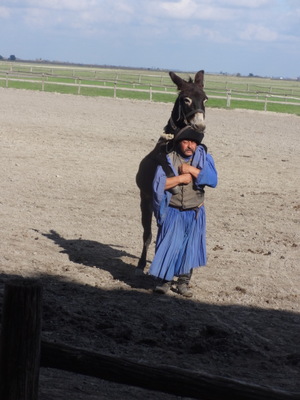
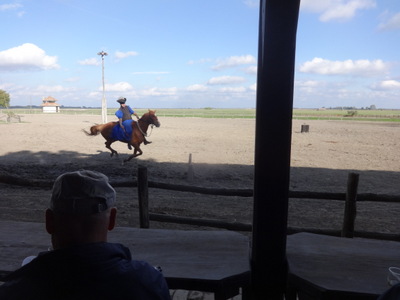 In addition, Sancho had the donkey stand behind him with its forlegs over his shoulders. Not sure what battlefield or agrarian activity that was supposed to be good training for—comic relief, I suppose.
In addition, Sancho had the donkey stand behind him with its forlegs over his shoulders. Not sure what battlefield or agrarian activity that was supposed to be good training for—comic relief, I suppose.
The next demonstration was of the technique for hunting rabbits or pheasants on horseback with a whip. The folks who had served us refreshments set up stumps just in front of our seats and balanced on them wooden pegs maybe the size of a 6-oz Coke bottle. Riders then galloped by and used their whips to snatch those pegs off without knocking over the stumps. The neck of a fleeing rabbit or pheasant would be no match.
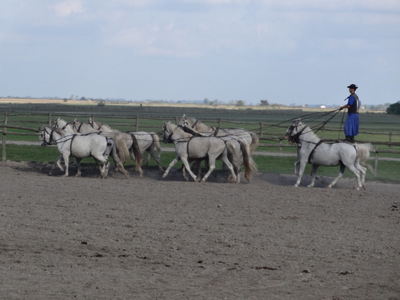
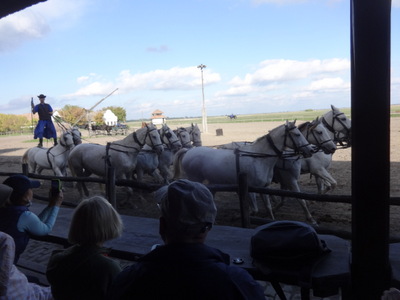 After that came the famous feat of driving a team of 10 horses while standing on two of them. According to our guide, somebody named "Cock" (Koch?) published an etching of a rider doing this with five horses, and the competition has been on ever since to increase the number of horses involved. The record is 20.
After that came the famous feat of driving a team of 10 horses while standing on two of them. According to our guide, somebody named "Cock" (Koch?) published an etching of a rider doing this with five horses, and the competition has been on ever since to increase the number of horses involved. The record is 20.
Anyway, this guy was driving two rows of four horses each, followed by the two he was standing on. They were going pretty fast, but as far as I could tell, the last two were not attached to the ones in front by anything but the reins in the rider's hands. He wore special boots with thick felt pads attached to the soles.
At the left is a telephoto of them just trotting across the arena, but at the right they've speeded up. Here they come . . .
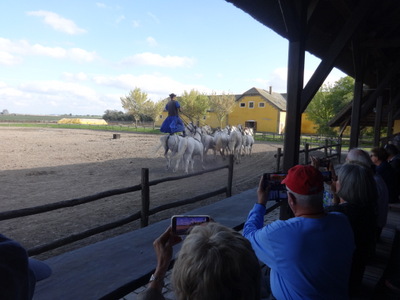
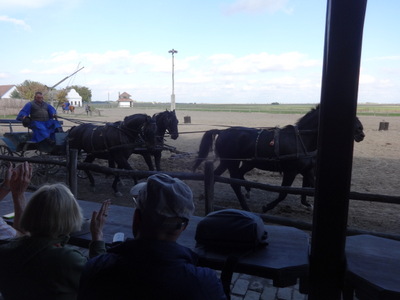 And there they go . . .
And there they go . . .
The final demonstration was of four-in-hand driving. This time, I would characterize the vehicle as a carriage—pretty much the same kind as the handsome one shown above—but clearly a beat-up old version for use in practice. The driver sat in front, and a passenger, the "balance man," rode in the back. It was the passenger's job to lean, or even throw himself, left and right as necessary to keep the carriage upright as the driver raced the team around barrels in a tight slalom course. I think this is the kind of competitive driving my cousin Jon and his wife used to do . . .
A three-horse team even made an appearance, pulling a smaller cart, just to demonstrate yet another traditional use of horses.
For the finale, everybody circled the arena together—riders, carts, carriages, even the donkey.
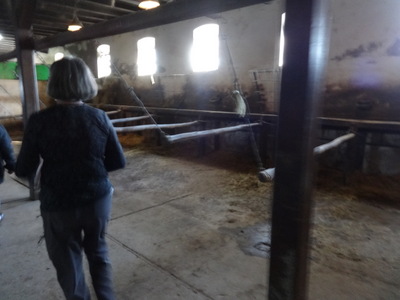
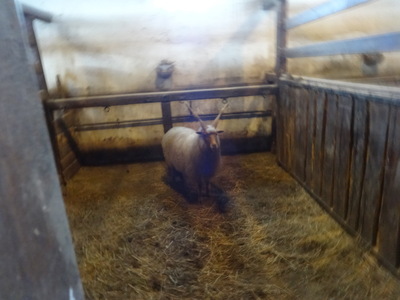 After the horse demonstrations, we had the chance to tour the stables or to take a carriage ride. I managed to fit in both by hurrying through the stables, then catching one of the last carriage rides.
After the horse demonstrations, we had the chance to tour the stables or to take a carriage ride. I managed to fit in both by hurrying through the stables, then catching one of the last carriage rides.
At the left here are some of the stalls, perhaps those of the horses we'd just seen outside, as they were empty.
At the right is a single specimen of the Hungarian "racka" (pronounced "ratska") sheep, which was straight spiraled horns.
We also saw a couple of breeds of pigs, some dogs, and rabbits.
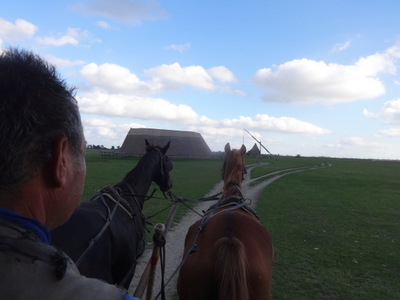
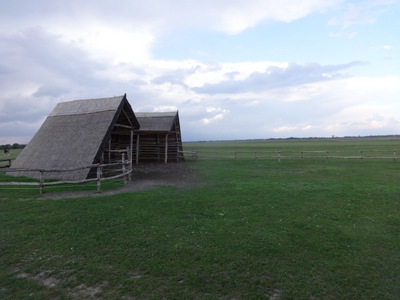 The vehicle giving "carriage rides" was what I would call a "char a banc"—a longish, canopied, horse-drawn wagon with seats along the sides for about a dozen people. At the left here is my view over the driver's shoulder.
The vehicle giving "carriage rides" was what I would call a "char a banc"—a longish, canopied, horse-drawn wagon with seats along the sides for about a dozen people. At the left here is my view over the driver's shoulder.
Our destination was a cluster of buildings visible in the distance from the bleachers. It included this pair of sheds, as well as a more barn-like structure and a well with a long counterbalanced lever for drawing water.
Then it was back into the buses for the trip back to the ship for dinner. Our guide explained that what we had just visited was a real working farm. The breed the animals, producing 40 to 50 horses a year, as well as sheep, the grey cattle, and about 100 pigs. They specialize in maintaining typical Hungarian breeds. They keep some of the horses for their own use, but they sell the excess, and they also grassfed meat beef, pork, and mutton and produce wool. They supplement their income by serving as a wedding venue—guests get a show like the one we saw as well as a dinner.
As we drove through the countryside, I again saw maize and sunflowers. The guide told us that this is also a region of high paprika production. Traditionally, the pods are harvested, strung together, and hung to try on walls with ventilation holes. Industrially, the pods are dried on perforated shelves by hot air circulation. Even those, though, are still harvested by hand because the pods don't all riped at once, and machines can't take only the red pods and leave the green ones. Unfortunately, the plants are only 50 cm high, so it's stoop labor. Sweet (as opposed to hot) paprika is the most commonly used, and 90% of it comes from Hungary. Once the pods are dry, only teh stems are removed. The rest is ground, seeds and all.
And before we'd been on the road long, the skies opened and we were pelted not just with heavy rain but with actual hail, clattering on the roof and bouncing off the windshield. But as was the case for this whole trip, as we passed a walnut grove just as we approached the river where our ship waited, the rain abruptly stopped, the sun came out, and we walked down the gangplank dry.
Before dinner, because some passengers would be leaving the ship the next day, briefing was replaced by the captain's cocktail party and a farewell toast.
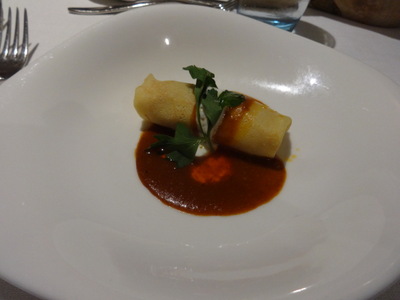
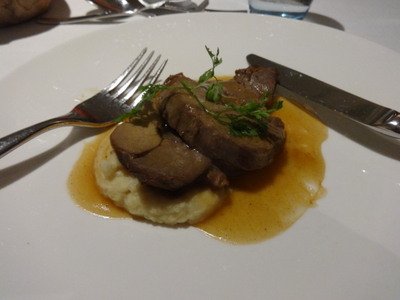 For dinner, I chose the appetizer from the traditional menu: chicken crepe roulade with paprika sauce.
For dinner, I chose the appetizer from the traditional menu: chicken crepe roulade with paprika sauce.
At the right is my main course: slow cooked and braised lamb with auliflower and celeriac purée.
Excellent.
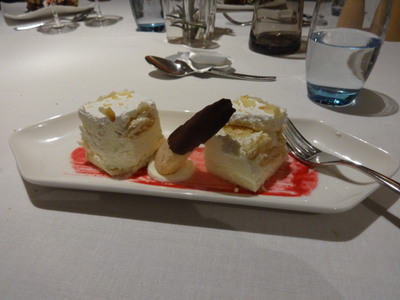 My dessert is shown here at the left. I've actually forgotten whether it was the "traditional Hungarian trifle" or the "Austrian almond layer cake." It had almonds in and on it, a thin layer of cake (or lady finger) at the bottom, and a chocolate-dipped lady finger on the side, but it was mostly solid whipped cream.
My dessert is shown here at the left. I've actually forgotten whether it was the "traditional Hungarian trifle" or the "Austrian almond layer cake." It had almonds in and on it, a thin layer of cake (or lady finger) at the bottom, and a chocolate-dipped lady finger on the side, but it was mostly solid whipped cream.
As we dined, the ship cast off and we cruised away toward our next destination.
The evenings entertainment was to be "Oldies and Goldies" by on-board musician George. I would have liked to listen in on the lounge cam, but it seemed pointless to watch him play and sing without sound!
I also had a look at the list of excursions I had compiled before leaving home, and sure enough, we were scheduled for a Hungarian horse show day after tomorrow. Would it be a different one? No, as it turned out (and as I had suspected a propos of the home visit), Viking had been jiggering with the schedules. Rather than see the same horse show two days later, they allowed us to choose a different excursion for that date.
Previous entry
List of Entries
Next entry
 At 5 am, the ship docked in Mohács, our first stop in Hungary (and, I'm told, the site of one of the most important battles against the Ottomans), to clear customs into the European Union. Up to this point, we had left our passports in the hands of the Viking staff, who kept them in a safe and got them out at each national border to check us into the new country without any effort or participation on our part—very convenient. At this point, though, where we officially entered the EU, the Hungarian authorities wanted to do a "face check," laying eyes on each passenger and checking what they saw against the corresponding passport. We were therefore told the night before to go about our business in the morning but to expect further instructions over the PA system.
At 5 am, the ship docked in Mohács, our first stop in Hungary (and, I'm told, the site of one of the most important battles against the Ottomans), to clear customs into the European Union. Up to this point, we had left our passports in the hands of the Viking staff, who kept them in a safe and got them out at each national border to check us into the new country without any effort or participation on our part—very convenient. At this point, though, where we officially entered the EU, the Hungarian authorities wanted to do a "face check," laying eyes on each passenger and checking what they saw against the corresponding passport. We were therefore told the night before to go about our business in the morning but to expect further instructions over the PA system.
 Once all the faces had been checked—our group was first, having the lowest cabin numbers on the ship—we cast off again and sailed on toward our first real stop in Hungary, Kalocsa.
Once all the faces had been checked—our group was first, having the lowest cabin numbers on the ship—we cast off again and sailed on toward our first real stop in Hungary, Kalocsa.
 I started lunch with two of the little appetizer salads—another vegetable assortment in mayo (this one flavored with dill) and a cold corn with herbs and bacon. For the first course I chose "corn chowder" with whiskey sabayon. My experience with Viking "chowders" reveals that they have no idea a what chowder is. I asked the waiter, who assured me it had no potatoes in it, so I wasn't suprised to get a sort of corn bisque rather than anything resembling a chowder. Good, though.
I started lunch with two of the little appetizer salads—another vegetable assortment in mayo (this one flavored with dill) and a cold corn with herbs and bacon. For the first course I chose "corn chowder" with whiskey sabayon. My experience with Viking "chowders" reveals that they have no idea a what chowder is. I asked the waiter, who assured me it had no potatoes in it, so I wasn't suprised to get a sort of corn bisque rather than anything resembling a chowder. Good, though.

 For dessert, we both had the Nutella panna cotta, but a surprising number of diners chose the banana split, which was fairly authentic—a split whole banana with vanilla, chocolate, and strawberry ice cream, topped with a couple of sauces. No whipped cream or cherry, though.
For dessert, we both had the Nutella panna cotta, but a surprising number of diners chose the banana split, which was fairly authentic—a split whole banana with vanilla, chocolate, and strawberry ice cream, topped with a couple of sauces. No whipped cream or cherry, though.
 Our guide told us his "proper Hungarian name" is Jerge (though I'm not sure how he spells that), but for today, we would be George.
Our guide told us his "proper Hungarian name" is Jerge (though I'm not sure how he spells that), but for today, we would be George.
 Looking to the right instead, you see these two statues. The white one is the first archbishop. The darker-colored one, farther away, is Saint Stephen, who was, in fact, that first king of Hungary, the one who founded the town! He was crowned on either 25 December 1000 or 1 January 1001 (opinions differ), and reigned until his death in 1038 (Catholicism and Orthodoxy didn't split until 1054).
Looking to the right instead, you see these two statues. The white one is the first archbishop. The darker-colored one, farther away, is Saint Stephen, who was, in fact, that first king of Hungary, the one who founded the town! He was crowned on either 25 December 1000 or 1 January 1001 (opinions differ), and reigned until his death in 1038 (Catholicism and Orthodoxy didn't split until 1054).
 Finally, before we went inside, George pointed out this more-or-less life-size statue of Franz Liszt, with facing the cathedral. Liszt was the best friend of one of the archibishops and stayed as a house guest in the palace six documented times. He played the organ we were about to hear, not for services but for concerts. His piano is in the ceremonial hall in middle of the archbishop's palace.
Finally, before we went inside, George pointed out this more-or-less life-size statue of Franz Liszt, with facing the cathedral. Liszt was the best friend of one of the archibishops and stayed as a house guest in the palace six documented times. He played the organ we were about to hear, not for services but for concerts. His piano is in the ceremonial hall in middle of the archbishop's palace.
 At the left here is a view of the ceiling, looking like it's made of Wedgewood china.
At the left here is a view of the ceiling, looking like it's made of Wedgewood china.
 We were met at the turn to the horse farm by a rider dressed like this in a long blue cape and feathered hat and wielding a long cattle whip. Under the cape he wore a blue shirt and trousers with flared sleeves and legs, and over that a black vest. Hungarian riders like this, called "csikos," are shepherds. They were the horse trainers and therefore high in the hierarchy of shepherds.
We were met at the turn to the horse farm by a rider dressed like this in a long blue cape and feathered hat and wielding a long cattle whip. Under the cape he wore a blue shirt and trousers with flared sleeves and legs, and over that a black vest. Hungarian riders like this, called "csikos," are shepherds. They were the horse trainers and therefore high in the hierarchy of shepherds.
 Several carriages were displayed in an open-sided shed. I thought this one was the handsomest.
Several carriages were displayed in an open-sided shed. I thought this one was the handsomest.
 The show started out slow, with these Hungarian Grey cattle. This breed was near extinction in the 20th century, when only about 100 remained. Now, thanks to farms like this one that breed them, they've been pulled back from the brink.
The show started out slow, with these Hungarian Grey cattle. This breed was near extinction in the 20th century, when only about 100 remained. Now, thanks to farms like this one that breed them, they've been pulled back from the brink.
 Next, galloping toward us from far away across the arena, came four horsemen with their whips coiled over their shoulders, accompanied by a portly Sancho Panza type on a galloping donkey. The guide told us that the senior rider was the stablemaster and that Sancho was the head trainer.
Next, galloping toward us from far away across the arena, came four horsemen with their whips coiled over their shoulders, accompanied by a portly Sancho Panza type on a galloping donkey. The guide told us that the senior rider was the stablemaster and that Sancho was the head trainer.
 Then came a demonstration of how well trained the horses are. Each one (donkey included) was made to kneel, then lie down, all with the rider still aboard. Each rider laid his saddle aside so that the horse could lie on its side, head on the ground, and legs extended. The riders then sat on the horses, reclined on them, stood on them, then stepped down and made the horses sit like dogs (apparently it's really hard to make a horse do that, and some of the horses were more reluctant than others).
Then came a demonstration of how well trained the horses are. Each one (donkey included) was made to kneel, then lie down, all with the rider still aboard. Each rider laid his saddle aside so that the horse could lie on its side, head on the ground, and legs extended. The riders then sat on the horses, reclined on them, stood on them, then stepped down and made the horses sit like dogs (apparently it's really hard to make a horse do that, and some of the horses were more reluctant than others).
 In addition, Sancho had the donkey stand behind him with its forlegs over his shoulders. Not sure what battlefield or agrarian activity that was supposed to be good training for—comic relief, I suppose.
In addition, Sancho had the donkey stand behind him with its forlegs over his shoulders. Not sure what battlefield or agrarian activity that was supposed to be good training for—comic relief, I suppose.
 After that came the famous feat of driving a team of 10 horses while standing on two of them. According to our guide, somebody named "Cock" (Koch?) published an etching of a rider doing this with five horses, and the competition has been on ever since to increase the number of horses involved. The record is 20.
After that came the famous feat of driving a team of 10 horses while standing on two of them. According to our guide, somebody named "Cock" (Koch?) published an etching of a rider doing this with five horses, and the competition has been on ever since to increase the number of horses involved. The record is 20.
 And there they go . . .
And there they go . . .
 After the horse demonstrations, we had the chance to tour the stables or to take a carriage ride. I managed to fit in both by hurrying through the stables, then catching one of the last carriage rides.
After the horse demonstrations, we had the chance to tour the stables or to take a carriage ride. I managed to fit in both by hurrying through the stables, then catching one of the last carriage rides.

 The vehicle giving "carriage rides" was what I would call a "char a banc"—a longish, canopied, horse-drawn wagon with seats along the sides for about a dozen people. At the left here is my view over the driver's shoulder.
The vehicle giving "carriage rides" was what I would call a "char a banc"—a longish, canopied, horse-drawn wagon with seats along the sides for about a dozen people. At the left here is my view over the driver's shoulder.
 For dinner, I chose the appetizer from the traditional menu: chicken crepe roulade with paprika sauce.
For dinner, I chose the appetizer from the traditional menu: chicken crepe roulade with paprika sauce. My dessert is shown here at the left. I've actually forgotten whether it was the "traditional Hungarian trifle" or the "Austrian almond layer cake." It had almonds in and on it, a thin layer of cake (or lady finger) at the bottom, and a chocolate-dipped lady finger on the side, but it was mostly solid whipped cream.
My dessert is shown here at the left. I've actually forgotten whether it was the "traditional Hungarian trifle" or the "Austrian almond layer cake." It had almonds in and on it, a thin layer of cake (or lady finger) at the bottom, and a chocolate-dipped lady finger on the side, but it was mostly solid whipped cream.